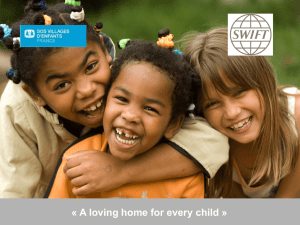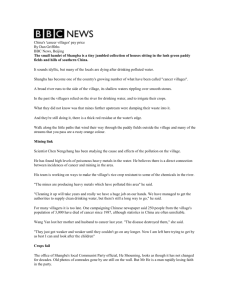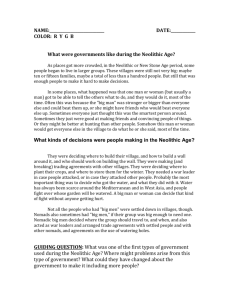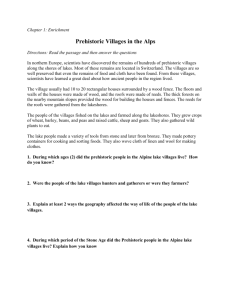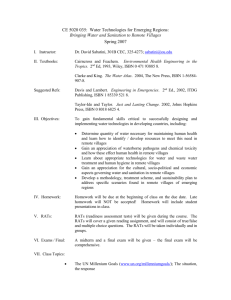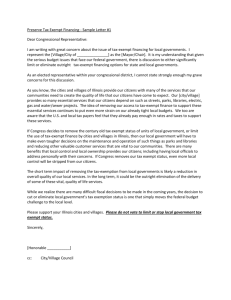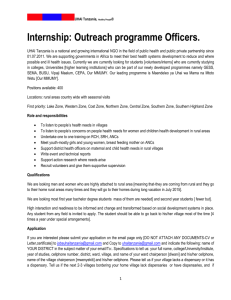First round of stakeholder meetings: WP6 questions
advertisement
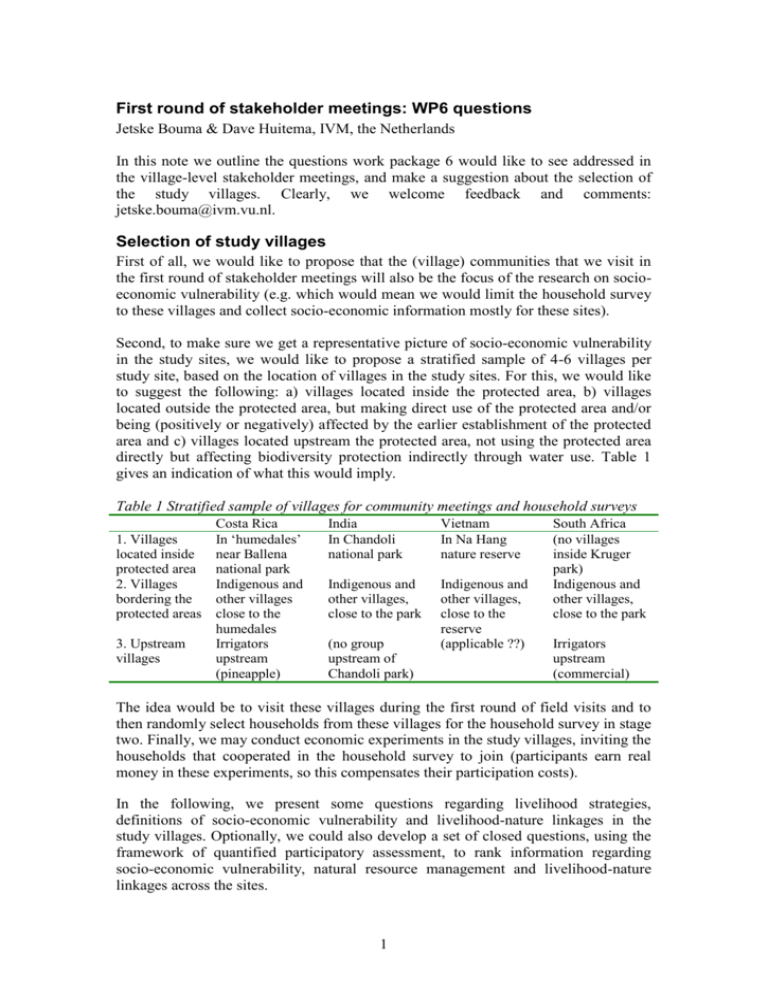
First round of stakeholder meetings: WP6 questions Jetske Bouma & Dave Huitema, IVM, the Netherlands In this note we outline the questions work package 6 would like to see addressed in the village-level stakeholder meetings, and make a suggestion about the selection of the study villages. Clearly, we welcome feedback and comments: jetske.bouma@ivm.vu.nl. Selection of study villages First of all, we would like to propose that the (village) communities that we visit in the first round of stakeholder meetings will also be the focus of the research on socioeconomic vulnerability (e.g. which would mean we would limit the household survey to these villages and collect socio-economic information mostly for these sites). Second, to make sure we get a representative picture of socio-economic vulnerability in the study sites, we would like to propose a stratified sample of 4-6 villages per study site, based on the location of villages in the study sites. For this, we would like to suggest the following: a) villages located inside the protected area, b) villages located outside the protected area, but making direct use of the protected area and/or being (positively or negatively) affected by the earlier establishment of the protected area and c) villages located upstream the protected area, not using the protected area directly but affecting biodiversity protection indirectly through water use. Table 1 gives an indication of what this would imply. Table 1 Stratified sample of villages for community meetings and household surveys 1. Villages located inside protected area 2. Villages bordering the protected areas 3. Upstream villages Costa Rica In ‘humedales’ near Ballena national park Indigenous and other villages close to the humedales Irrigators upstream (pineapple) India In Chandoli national park Vietnam In Na Hang nature reserve Indigenous and other villages, close to the park Indigenous and other villages, close to the reserve (applicable ??) (no group upstream of Chandoli park) South Africa (no villages inside Kruger park) Indigenous and other villages, close to the park Irrigators upstream (commercial) The idea would be to visit these villages during the first round of field visits and to then randomly select households from these villages for the household survey in stage two. Finally, we may conduct economic experiments in the study villages, inviting the households that cooperated in the household survey to join (participants earn real money in these experiments, so this compensates their participation costs). In the following, we present some questions regarding livelihood strategies, definitions of socio-economic vulnerability and livelihood-nature linkages in the study villages. Optionally, we could also develop a set of closed questions, using the framework of quantified participatory assessment, to rank information regarding socio-economic vulnerability, natural resource management and livelihood-nature linkages across the sites. 1 Questions for village-level stakeholder meetings LiveDiverse 1. General Details Village name Location (inside protected area, outside, upstream) GPS coordinates Date of the meeting Total participants (male/female) 2. Village Details Total number of households or inhabitants Total area (km2 or ha) Does the village have a formal administrative authority? (mayor, other) Does the village have an informal, traditional authority (elder, chief, etc.) Are the authorities present at the meeting? Village type (Indigenous, non-indigenous or mixed)? Connected by tarmac road? (Y/N) Distance to nearest (market) town (km) 3. Livelihood strategiesList the 5 main livelihood strategies of households in this village 1. 2. 3. 4. 5. (for example: combinations of subsistence farming (crops and/or livestock), wage labour, commercial farming, crafts, tourism, hunting, fishing, NFTP’s, etc ) 4. Income from natural resources- opportunity costs List the prices (per kg, piece or else) on the local market for some of the products villagers sell. 1.NFTP’s 2.bushmeat (hunting) 3.fish and shell fish 4.livestock 5.crops 6.timber 7.other (for example: combinations of subsistence farming (crops and/or livestock), wage labour, commercial farming, crafts, tourism, hunting, fishing, NFTP’s, etc ) 5. Livelihoods-nature linkages Describe the dependence of each livelihood strategy on natural resources/the ecosystem 1. 2. 3. 4. 5. (for example: use of land and water for crop production, use of forest to feed livestock, use of wood for drafts, use of NFTP’s or trees for commercial purposes, etc.) 2 6. Other dependence on ecosystem services List the main sources of water for: Drinking and cooking Bathing Washing/cleaning Other List other uses of nature for household subsistence and health Construction (boats, houses) Health (medicines, other) Food (hunting, gathering etc) Other 7. Property rights and ecosystem access List for each livelihood-nature linkage (question 4) who owns the land or resource entitlement 1. 2. 3. 4. 5. (for example, private property, community land, protected area/ government land, other) Do the same for the uses of nature listed under question 5. 1. 2. 3. 4. 5. 8. Natural resource and ecosystem management List for each livelihood-nature linkage (question 4, 6) how land/resource use is managed 1. 2. 3. 4. 5. (for example, informal rules, government enforcement, private management, other, none) Do the same for the uses of nature listed under question 5. 1. 2. 3. 4. 5. 9 Informal rules, social sanctioning and community control If the community has defined certain rules and/or uses social sanctioning or other mechanisms to enforce sustainable resource use, then please discuss what these mechanisms are, since when they have been in place and how effective they seem to be. 3 10 Community participation If the community participates in the management of the protected area and/or in the management of natural resources (water, land, forest etc.) in any other way, please discuss what participation entails (planning, decision-making, rule enforcement, etc.), since when the community has been participating and how effective community participation seems to be. 11. Details of village organizations/user groups Name of the Type of group Group 1. 2. 3. 4. # members # female members 12. External shocks- village scale What have been the main external shocks (environmental, political, economic) to the village in the last 10 years? List the main shocks, mentioning year, type of shock and main impact. Year Type of shock Main impact 1. 2. 3. 4. 5. 13. External shocks: village response Has, and if yes how, the village tried to do anything to avoid, or adapt to, these shocks? If yes, list community responses per shock (see question 12). 1. 2. 3. 4. 5. 14. Definitions of poverty Discuss the 5 characteristics that determine whether a household is poor. 1. 2. 3. 4. 5. 15. External shocks-household scale List the external factors that cause households to become poor (disease, crop failure, other) 1. 2. 3. 4. 5. 4 15. External shocks-household response Do, and if yes how, households try to avoid, or adapt to, these shocks? If yes, list the household responses per type of shock (see question 14) 1. 2. 3. 4. 5. Any other relevant information about socio-economic vulnerability in this village? 5


